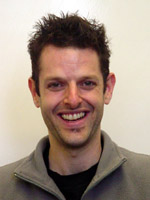|
||||||
Current ResearchFilling Biodegradable Scaffolds with a Cell Invasive Matrix for Bone Tissue Engineering. The emerging field of bone tissue engineering attempts to replace or augment the current approaches to bone grafting by using porous biodegradable scaffolds to support the migration, proliferation, and differentiation of osteoprogenitor cells in three dimensions. Many typical bone tissue engineering strategies ignore fundamental biology and do not consider the extent to which the scaffold pores fill with blood. Instead of relying on blood to uniformly fill the pores of tissue engineering scaffolds, I am investigating whether pre-filling the pores with a cell invasive matrix can lead to a better bony wound healing response. One method I use to look at cell migration is called the “Scratch Assay” – Click on the button to see cells migrating.
Previous ResearchPrior to beginning my PhD, I worked on the following research projects:
Awards and Scholarships
PublicationsKarp J.M., Rzeszutek K, Shoichet MS, and Davies JE. Fabrication of Precise Cylindrical Three-Dimensional Tissue Engineering Scaffolds for In Vitro and In Vivo Bone Engineering Applications. J Craniofac Surg (In press). 2003. Oprea W.E., Karp J.M., Hosseini M.M. and Davies J.E. Effect of Platelet Releasate on Bone Cell Migration and Recruitment In Vitro J Craniofac Surg (In press). 2003. Karp, J.M., Dalton, P.D., Shoichet, M.S. (2003) Scaffolds for Tissue Engineering. MRS Bulletin on Cellular Solids; Vol. 28(4):301-306. Karp, J.M., Shoichet, M.S., Davies, J.E. (2003) In vitro characterization of the bone-PLGA interface for 2-D surfaces and 3-D bone tissue engineering scaffolds. J Biomed Mater Res; 64A:388-96. Davies, J.E, Karp, J.M., Baksh D. (2001). Mesenchymal Cell Culture:Bone. In.“Methods of Tissue Engineering”, (A. Atala & R. Lanza, eds), pp. 333-344. Academic Press, San Diego, USA. Marino, F., Karp, J.M., Cooper, D.G. (1998). Biomass Measurements in Hydrocarbon Fermentations. Biotechnology Techniques, Vol. 12,(5):385-388, May 1998. AbstractsKarp, J.M., Rzeszutek, K., Davies, J.E. (2001). Shaping 3-D biodegradable scaffolds for tissue engineering. Biomaterials in 2001: state-of-the-art. UWEB fifth summer symposium. Seattle, Washinton USA. Aug. 19-21 Karp, J.M., et al. (2001) "A Model For Biomaterials Education from Students’ Perspective", Transactions of the 27th annual Meeting of the Society for Biomaterials. St. Paul Minnesota. USA. April 24-29 Karp J.M., Shoichet M.S., and Davies. J.E. (2001) “In Vitro Characterization of theBone PLGA Interface” Transactions of the27th annual Meeting of the Society forBiomaterials. St. Paul Minnesota. USA.April 24-29 Personal InterestsDjembe African drumming, water skiing, rollerblading, and Balcony gardening.
|
||||||
| Copyright © 2005. IBBME University of Toronto. All Rights Reserved. |
